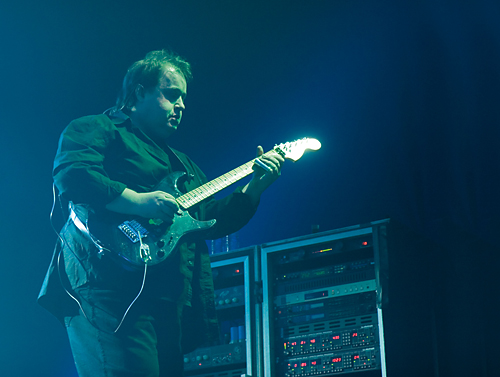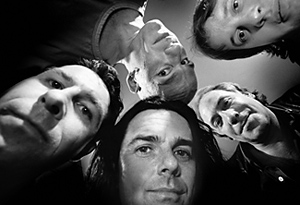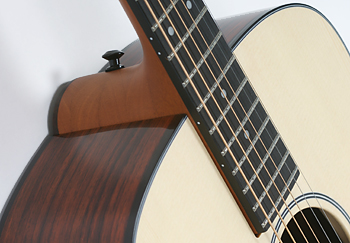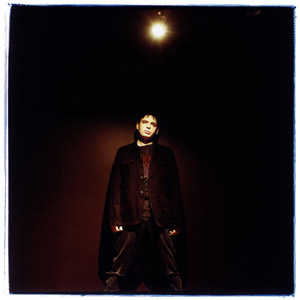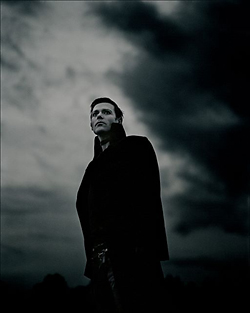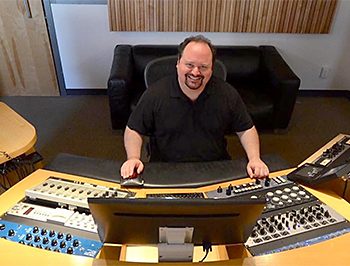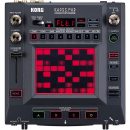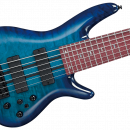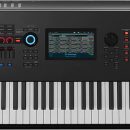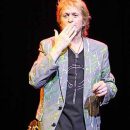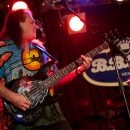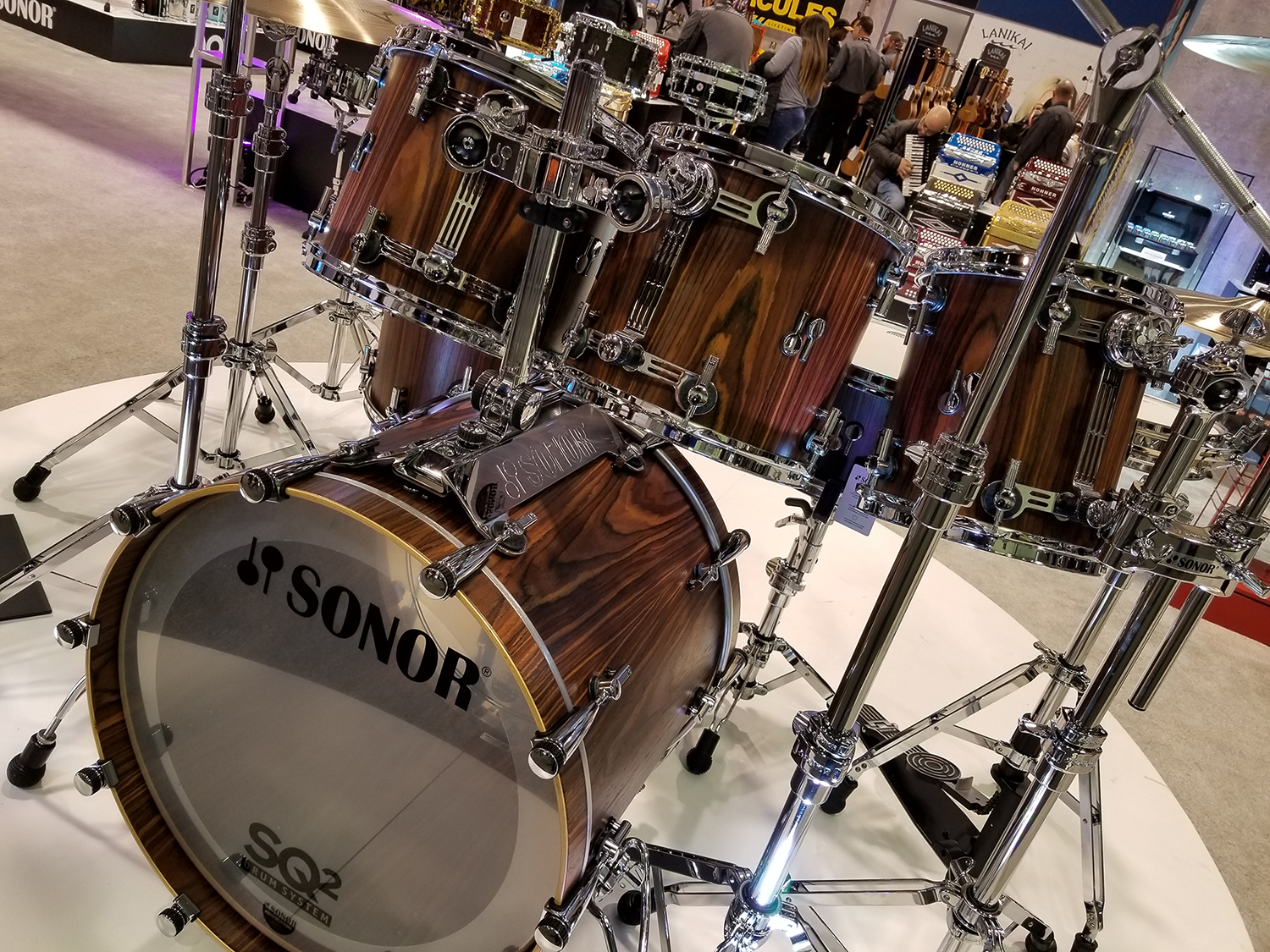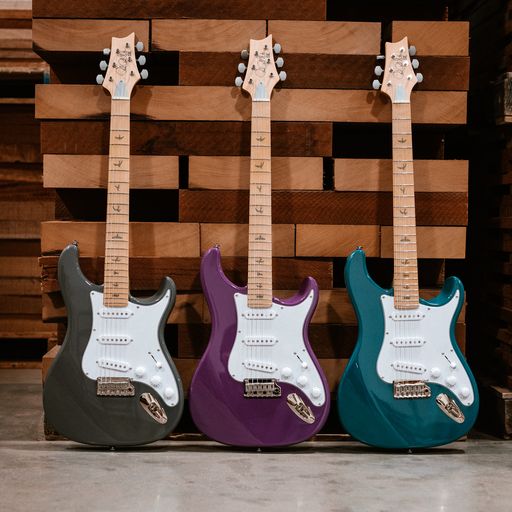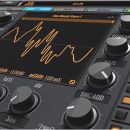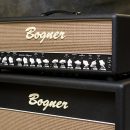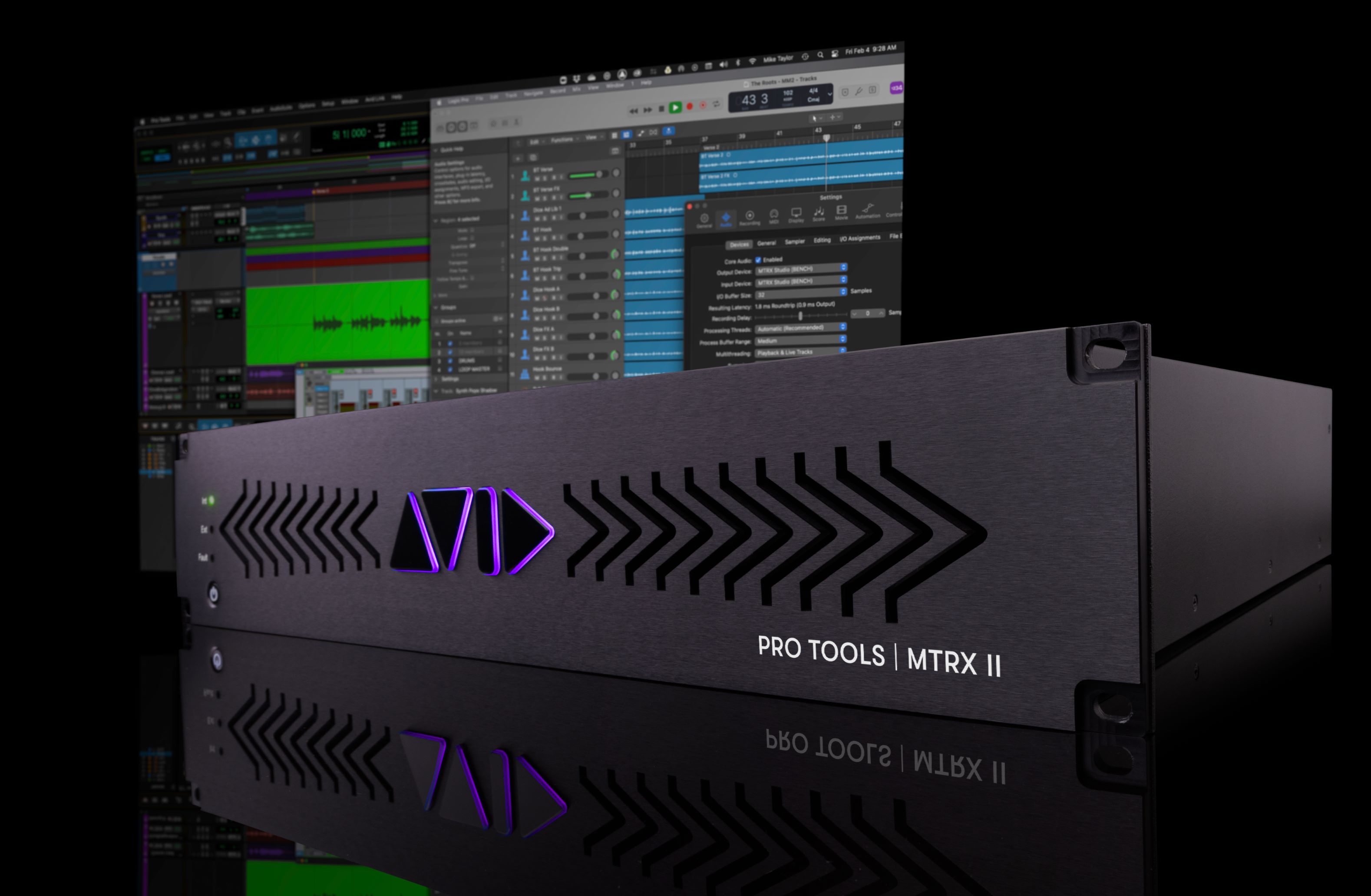If you were to ask any progressive-rock-loving guitar player for some great players to discover, the list would probably include the likes of John Petrucci, David Gilmour, Alex Lifeson, and Steve Rothery.
An incredibly talented player, Steve’s tone is sure to appeal to fans of diverse guitar sounds. If you love guitars drenched in shimmering chorus, sparkling delays, and cavernous reverbs, Steve’s one of the guys who practically wrote the book on that tone. Arpeggios? Open voicings? You bet! But he also has a formidable blues style about him as well, probably placing him more firmly in the same bunk with Gilmour than some of the other heroes of prog.
Spend some time listening to Marillion and you begin to discover the many layers of sound that Steve contributes, from those spacey sounds and blues sections to acoustic rhythms that anchor the melodies. Never one to go for major flash, he always plays for the song and not his ego, but when he shines, he shines brightly. His guitar playing soars and takes you to another place.
Rothery is one of my biggest musical influences, and it was both an honor and a pleasure talking at great length with him both during this interview and a week prior during a special advance album listening party in New York City.
“I think acoustic guitars help cement things rhythmically,
and it’s such a nice sonic texture to use on records.”
MPc: So let's start with the new album, Somewhere Else. Tell us a little bit about your approach to playing guitar on the new record.
Steve: The way the album was put together was slightly different from normal – we worked with Mike Hunter on this record. The way we always write is that we all get together in a room and jam around ideas and record everything to minidisk. So then after a while, we take these best moments and make them the starting points for the song. But the part that we find most difficult, often, is the arranging part, so we actually passed a lot of that on to Mike. He would go away and come back with suggestions for us to try in terms of arrangements.
But in terms of the guitar approach there’s a lot of guide guitars that we use, where you kind of do four or five takes of a song and usually the way I do it is that I try, rather than just playing the same thing every time, each time I try something a little bit different, like different sounds or different approaches. So quite often it gives you a lot of what you need so you can put together an interesting track. You know, with different sorts of approaches you can use little tiny moments from each. I think that works well.
I think [the new record] probably has slightly less effects on most of the tracks… classic sounds, an [Roger Linn] AdrenaLinn pedal on some things, a Hughes & Kettner Rotosphere for that kind of leslie sound.
MPc: I actually have in my notes that I noticed your rhythm guitar sound in particular is a lot less atmospheric on the new record.
Steve: Yeah, I think… Mike maybe was keener for it to be not so heavily effect laden. But I think it depends on the song, you know? Sometimes it’s great to have all those different sort of effects to give it a different texture and mood; other times it’s not what the song needs. So my first priority as a musician is always to listen to the song and try to find just the right thing for it, both in sonics and in parts, really.
MPc: I also noticed a lot of acoustic guitar, including an acoustic guitar solo on “The Wound.”
Steve: Yeah, it’s kind of one of those things really… I think acoustic guitars help cement things rhythmically, and it’s such a nice sonic texture to use on records, you know, for lifting up a section. So I think that kind of works really well. The whole approach on this record is probably not so much about too many layers and overdubs like we had in the past with Dave Meegan’s approach, which is very much just a ton of overdubs sorted out in the mix. This was a little bit more thought through, I think. So in a way, that’s good because you have those touches you can use, but you don’t have the problem of having to cram too much into the mix.
You know, everything also gets more spaced out in the soundscape really, if you’ve not gone overboard with overdubs, I think.
MPc: Some guitar players are known for one particular trademark sound, but in your case I would have to say that I think there are three distinct “Rothery Sounds” as I’ve heard them. One of them would be your sparkling clean arpeggio tone that is usually draped in beautiful digital delays. The next one would be your soaring melodic lead tones, and the third would be your classic blues tone. I’d love for you to talk with us about those, and how your sound has evolved over the years.
Steve: In the old days, we’re going back a few years, from our second album, Fugazi, through pretty much to probably Radiation, the two amps I used were a Marshall master volume head on a 4x12 for the crunch sounds, sort of heavy chordal sounds, and a [Roland] JC 120 which I used with various effects: digital delays, BOSS chorus, BOSS DS-1 distortion for solo sound… And that was kind of what I used to use for that clean picking arpeggiated sound. And sometimes I also used, with a slight variation, various [Scholz/SR&D] Rockman modules into an old [Alesis] Quadraverb, which gives a very clean, bright, compressed sound. I think if you really whack up the spins and the amount of reverb, you create something quite unusual that sort of sits on the top of what you think the normal guitar sound is gonna’ be.
But in terms of my classic solo sound, what I’ve used for most of my career is a Strat with EMG SA pickups into the Boss DS-1 distortion into some sort of digital delay, into the JC 120, and that’s kind of the sound on virtually all the records. The last two or three have changed a little bit. From Anoraknophobia onwards, I started using an amp that I’d had for a while but I hadn’t really used much in the studio, which was a Groove Tubes Trio preamp and Dual 75 power amp. And around the Anoraknophobia album I started using that with a Lexicon MPX G2, which is great sounding box.
I’m not playing a very complicated part, but just using the sound to create the atmosphere and the mood.
MPc: I was looking at a photo of you with your rack behind you and noticed a few duplicates of gear, and also some classic TC Electronic 2290 delay units.
Steve: Yeah, some of that’s a spare. Sometimes, I was using an MPX G2, which is a great sounding box but with a couple of limitations – it’s got 300 presets but only fifty user presets, which is the first one. The second one is that it’s actually very slow switching between presets, so I decided on the Marbles album to incorporate one of my 2290s, so that does most of the switching because it’s instantaneous with patch changes, and it’s a great sounding unit anyway, which also meant I could use other things in the loops for that. So the signal goes from the guitar into the first part of the Lexicon which has got various modulation and distortion possibilities, out of that into the Trio preamp, then out of the Trio into the TC 2290 and out of that into the power amp. On the 2290, I can then post-preamp add things like the Hughes & Kettner [Rotosphere] pedal, the Adrenalinn and on this album a [Electro-Harmonix] POG Polyphonic Octave Generator.
[Also in the rack is] a BOSS CE-300 rack-mounted chorus. I’ve tried loads of other chorus pedals and I always come back to the sound of this. For me, the best chorus sound you can get is to try to find one of these second-hand on eBay. I think they stopped making it probably about twelve years ago, but I think it’s got great character.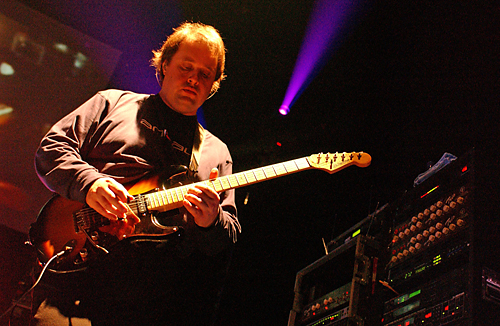
I was trying a Carl Martin pedal yesterday which is supposed to be based upon it, and although it sounded good and it sounded cleaner than this one, it just didn’t do the same thing to the sound, like the edge of the waveform was almost too abrupt, so if you try to use too much Depth it just made it sound kind of unpleasant to me, like it was pulling the pitch too far. I think a great solo sound and a great chorus sound are just so important for an arsenal of sounds. I mean there are great sounds as well like a leslie pedal or a tremolo pedal. But having those different things at your disposal will really, really help.
MPc: Can you point out a couple of the songs where you make use of some of your specialized effects so that people can actually notice and say “Oh, so that’s how it's used?”
Steve: Well the clean picking sound at the front of the track called “The Wound” on the new album – that’s the POG pedal. The Adrenalinn pedal was used an awful lot on Marbles at the beginning of “Invisible Man,” “Drilling Holes”… the great thing about the Adrenalinn is that it’s synched to MIDI clock, so you have these great modulations and sort-of step sequences that, once you synch through MIDI clock, it’s tracking those tempo changes in the song. And that [pedal] can create an amazing groove. I’m not playing a very complicated part, but just using the sound to create the atmosphere and the mood that you’re trying to put forward.
MPc: And how do you keep your delays in synch with Ian during live shows?
Steve: We have a chain of visual metronomes, that we call Mr. Blinkey. (laughing) It’s a MIDI metronome. Mark [Kelly, keyboards] sets up a tempo for each song so we have that flashing at us, to give us a rough guide of where we should be, (laughing) which kind of works pretty well, actually. I think that, especially certain things, when you’re triggering maybe samples from MIDI bass pedals, it’s obviously very important if you’re doing that not to deviate too much from the tempos otherwise things are finishing at the wrong time and it can sound like a bit of a mess.
MPc: And where do the Laney amps you’re associated with fit into all of this?
Steve: We have a really good relationship with Laney. Around the Anoraknophobia time we were flying in and out of a lot of countries, and the only way economically we could do it was to have equipment supplied. And they’ve always been really supportive of the band. So I found amps in the Laney range that would do the equivalent of what I was using the Marshall and the JC 120 for. So they were kind of like substitutes, if you like, for those amps.
Some of the Laney amps I think sound really good: their little ChromeOzone combo, I’ve got a little… I think it’s a fifteen-watt, Class A combo, I don’t think they make it anymore. Those in particular I think sound really, really good. But for me, I always go back to my Trio, because I just love… the tone controls. You know, their frequencies and the way that they interact with each other, are extremely musical on the Trio. In the past I’ve actually used the Trio preamp into the power amp section of the Laneys as well. But you know, you kind of try different things and my ultimate, really, is to go into the Groove Tubes power amp into a Marshall 4x12 with Celestion Vintage 30s. You put a Beta 57 in front of that and it’s just a great sound, really.
MPc: With your cool delay sounds, do you run your rig in stereo?
Steve: I haven’t bothered much with stereo. The only time was on the first album with Steve [Hogarth], Seasons End, on the “King of Sunset Town” intro, and also on the front of “Berlin” – I was using two JC 120s and the TC 2290 can pan across then in stereo. So I had that happening. But really, most of the time I’m running in mono. If I’m using both sides of the stereo power amp, I’m more likely to have, when we’re writing, an Echoplex looper and one of the BOSS DD-20 things. I can loop up a guitar part and send it through a different cabinet, and balance the gain of that sound with my main amp, which is handy for writing. I actually quite like writing with loops like that. To be a guitarist in a band with two keyboard players you have to be sneaky like that! (laughs)
MPc: Well it’s funny. Despite Mark and Steve playing keyboards, you’ve got so many layers of guitar parts in so many songs. How do you pull it off live in terms of picking and choosing what to play?
Steve: Well it really depends on the tracks. Sometimes you just approximate it. Sometimes you can get away with samples and parts being triggered, especially if it’s power chords or single strums.
MPc: And when you’re doing that, are those being sequenced or is Mark actually playing samples of your guitar?
Steve: Sometimes Mark; sometimes Pete [via MIDI foot pedals]. But Steve also plays guitars live occasionally. So you know, quite often between us we likely have something pretty convincing.
I’m personally not nuts about POD-type sounds.
MPc: Tell us about the guitars that you’re playing – the Blade line is not very well known in the United States. Are they your guitar of choice?
Steve: Yeah, actually, I’ve tried loads of guitars – high end ones, Tom Andersons… But for me the Blades have a nice compromise between playing well, sounding great, and not being ridiculously expensive. Sort of very versatile, you know? They’re a passive guitar with an active circuit you can switch in, so you can have either a mid boost or a treble and bass boost, and with pots in the rear to adjust the amount of boost that you give to those frequencies. I changed the pickups to put Lindy Fralin pickups in nearly all my guitars – the vintage pickups, which are a great sounding pickups, and really it’s just down to the individual guitar. More important than even the make, really, is [whether] it is a good piece of wood.
Quite often you’ve got to change the pickup, sometimes the electronics, to get exactly the sound in your head anyway. But that isn’t a big deal – you’ve just got to find a piece of wood with the right resonance. And sometimes you pick up a guitar and it sounds right and it feels right, and you can play half a dozen different guitars in the same range from the same manufacturer, but there might only be one that has that feeling for you.
So I think that’s a really important thing when people are buying guitars – they should try as many as possible. All my guitars… I’ve got how many now? Oh I’ve probably got around eleven or twelve, but they’re all very carefully selected like that. I mean I’ve got three Blades – two Strats and one Tele. I’ve got a couple of normal [Fender] Strats with EMGs, [Gibson] Les Paul, a custom made Steinberger double-neck that’s got three single coils on each neck, various acoustics…
MPc: I’ve noticed, lately, you’ve been playing Takamine acoustics.
Steve: Yeah, again I think they do the job. They’re kind of like a workhorse really. Especially live, the Santa Fe and a twelve-string. I think you could probably get a slightly better [acoustic]… I think technology’s come a little bit in terms of acoustic guitar pickups and sound, but the twelve-string especially is not a killer. So many twelve-string acoustics are quite unpleasant to play, and this one sounds great and, you know, it’s a joy to play.
Maybe its because I’m a Yorkshireman, you know, which is from the north of the country and we’re very conscious of spending money, traditionally. (laughs) But it’s like I say – it’s a tool at the end of the day, and you want it to do what you want it to do. You don’t want it to limit your performance, you want it to sound good – as good as possible, but it’s got to stand up to rigors of life on the road.
MPc: What do you do to capture a really good, recorded guitar tone?
Steve: Well we usually look at each stage, depending on the sound that you’re after, really. There’s that sort of bluesy tone: you know it’s gotta’ be good pickups, it’s gotta’ be a good piece of wood, and then after that, sometimes using effects pedals, sometimes plugging straight into the amp, depending on how that amp responds to that particular guitar.
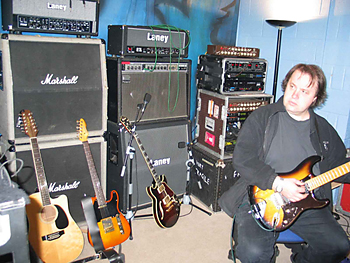
MPc: And how about the recording aspect of it, in terms of the cabinets and the mics?
Steve: Let’s say about a Marshall 4x12 with Celestion Vintage 30s. I usually like a [Shure] Beta 57. Mikey uses various microphones like a Sennheiser MD 421. But it’s gotta’ sound great at the amp, I think that’s the thing. You can only get on tape or hard disk what’s coming out of the speaker. I’m personally not nuts about POD-type sounds. I’ve got [Native Instruments] Guitar Rig 2, which I use on the PC, and I think for writing it’s great – very convenient if you have to, like I do, travel over to California to work with Hannah from the Wishing Tree. It’s amazing just to take a laptop and a guitar and a little interface and you know you’ve got something you can write with. But it’s very unusual that I’d want to use something like that on a record. And even down to using speaker simulators, I tried one over here that’s supposed to be really, really good, and compared to a mic on a 4x12, it just didn’t compare.
MPc: I find it really surprising that Steve Wilson from Porcupine Tree actually records his guitar using a lot of Line 6 PODs considering that he plays great Bad Cat amplifiers live.
Steve: Yeah I’ve often talked with Steve [Wilson] about that in the past. I just don’t understand it. I can see it from the convenience side, but, I mean, if I had to criticize Porcupine Tree, that’s probably one of the only things that I think… you know, they take so much care over everything, and sonically their records do sound great, but I think they’d sound even better if, you know, he recorded guitar properly! (laughs)
MPc: (laughs) Exactly. Do you make much use of an EBow for your more orchestral guitar lines?
Steve: No, most of the time it’s all done by hand, however I’ve rarely ever used EBow. “You’re Gone” is pretty much all EBow. But god, there’s not much else – maybe the beginning of Misplaced Childhood, the occasional line here or there. But something like the last solo on This Strange Engine, which kind of sounds EBow-ish, is all done with controlled feedback.
The sound that I get with a DS-1 – the distortion is turned up full, the tone control is backed off all the way, and the amp has to be quite loud, and it has to be directly behind you, kind of at waist height, and then it’s finding the the sweet spot really in terms of volume and angle to that. Then obviously if it’s that overdriven, you have to mute all the strings you’re not currently playing on that track. It’s all kind of pulling off a lot of it anyway to open B, but it gives a kind of very fluid, singing, sound.
MPc: Do you make use of any alternate tunings in your playing?
Steve: Not really [with Marillion]. The only time I’ve done much of that really is with the Wishing Tree, on the first Wishing Tree album, and on the new one I’m just finishing. I think it’s just some drop D tuning. Most of the time I kind of go for the same sort of rich melodic quality that you get with chords and open tuning, but just in standard tuning.
MPc: Could you share any tips for our readers regarding your delay settings and technique for playing classics like “Cover My Eyes?”
Steve: “Cover my Eyes,” I think, is about 390 milliseconds, not too much on the feedback control, and on that particular part [the delay] has to be quite loud – you want the delay sound to be virtually as loud as the original signal. I think it’s 389, actually thinking about it, and it’s played with the thumb and first and second finger sort of stamping it slightly, capo at second fret, and then playing in the delays really to get the bounce of the count of the rhythm.
MPc: Thanks! I’m sure people will be very excited to hear little stuff like that thrown into our interview. (laughs)
Steve: Actually, we, were approached by EMI publishing a few months ago that they were launching this thing over here because the research has just shown that all the skilled kids now are learning the guitar – it’s taken over from all the orchestral instruments as the instrument of choice in schools. So what EMI Publishing are doing are launching this kind of website where people can download online video lessons of people – stars showing basically how to play their hits, playing various songs you know, going through there with close-ups on the hands and showing the proper chord diagrams.
It might well be that I do something like that later this year for anyone that’s interested, but maybe something more in depth, like having a twenty-minute bit on each track going into not only the technical aspects of playing it, but how the sound is created.
MPc: That would be of immense interest to a lot of your fans, even if you did something like that on the Marillion website.
Steve: Yeah, I think just the way that they were talking about five dollars per download for each lesson – I think that’s probably to much. But I think there would be a few thousand people who might be interested in that. I think it’s always frustrating when you’re trying to learn somebody else’s part, especially if it’s something a bit unorthodox. So yeah, that’s something I might well do later on in the year.
MPc: Finally, what’s going on with the Wishing Tree? Your work with the Wishing Tree is a little different than traditional Marillion music.
Steve: The new Wishing Tree album, which I’m trying to finish at the moment, is probably a little bit more similar to Marillion than the first one was. But it’s always an opportunity, when you’re doing something outside the band, to experiment and find different things. I’ve got a myspace page for the Wishing Tree that I put a couple of sound clips on at the beginning of September, and it’s already had over 70,000 plays and lots of great comments, so it’s looking pretty good for the next record.

